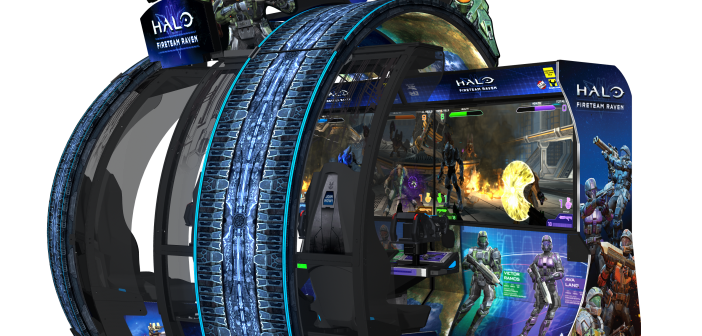 Halo Blasts into the Arcade!
Halo Blasts into the Arcade!
Game Combines Popular Console Franchise with Epic Scope & Scale
In the beginning, the video games took form in large, wooden cabinets housing miniscule, yet entirely innovative, games. As years went on and the technology improved, games became more complex and soon popped up in homes nationwide. At the time, those home games came almost directly from a pool of massively successful, recognizable titles in the arcade.
Today, the tables have turned as the arcade world finds itself looking toward what’s popular in the home for inspiration, and that’s most certainly the case with the newest Raw Thrills/Play Mechanix game: Halo: Fireteam Raven.
A collaboration between the coin-op gamesmiths, Microsoft and 343 Industries, the game is headed to Dave & Buster’s for an exclusive period starting this month and will be available to the whole industry as of August 20th.
The game pulls from the well-loved Halo series of games, which follow the galaxy-saving exploits of a super-soldier named Master Chief, his trusty AI Cortana and a host of other characters. Raw Thrills and Play Mechanix’s arcade installment will follow the story of some of those ancillary characters: a team of soldiers setting out to support Master Chief and help him in his heroics.
It’s a four-player shooter that truly packs a punch, coming with an unprecedented 130” panoramic 4K display and immersive 5.1 surround sound (which, for fans of the series, is a big deal, seeing as the music of Michael Salvatori has engendered a fanatic fan group itself!) The game is housed in a 9’ tall, 11’ wide cabinet themed to look like the superweapons that give the game its name, and offers plenty of visibility to draw a group of gamers and a crowd watching them. Additionally, legions of Halo players will be able to take the fight from their home consoles to your arcade by quickly linking their Xbox Live accounts within Halo: Fireteam Raven to earn unique achievements and awards.
 The arcade mainstays at Raw Thrills and Play Mechanix have been working on the game since 2012, when Eugene Jarvis approached Microsoft with the idea, and the struggle to obtain a license as beloved as Halo took time and effort.
The arcade mainstays at Raw Thrills and Play Mechanix have been working on the game since 2012, when Eugene Jarvis approached Microsoft with the idea, and the struggle to obtain a license as beloved as Halo took time and effort.
“It took a lot of convincing,” said Play Mechanix owner George Petro. “We got shut down a few times, but I got word from friends at Microsoft to not be discouraged. In the end, it took about four years to get the license and two years to make the game.
“But I think what really got things moving from our side is we essentially shipped Microsoft a Terminator game so they could see what we were about. That really got their attention!” he said.
Soon after, as the relationship between the companies grew, the deal was underway. Petro says that many times in the past, working with licensors who are difficult in the run-up of a deal means working with them throughout development will be a pain. However, with Microsoft, he said once they were in, they were all the way in.
“Normally, when we do development, there’s one person we deal with,” explained PM Creative Director Will Carlin. “With Microsoft, there was an entire team right away. They worked closely with us to help us capture all the nuances of the canon and the feel of the world. We wanted to put people back in time, when walking into an arcade meant having peoples’ jaws drop with wonder, and Microsoft was supportive of that.”
By the end of the process, Microsoft was sending their top teams to check out the game, including longtime Halo creator and Franchise Development Director at 343 Industries Frank O’Connor and Executive Producer Kiki Wolfkill.
“These guys really wanted to make sure we were making a great game,” Petro said. “Microsoft sent a team of lower level people at first, then those that were a step up, then a step up beyond that, and soon we were working with some of the top people in the franchise. And they loved it! It gave the whole team energy to see them laughing, shouting and playing the game as it was developed.”
 According to Petro and Carlin, the process was mutually constructive throughout development, with Microsoft providing suggestions (including help writing dialogue), but not limitations. Instead, the support allowed Carlin and his team to push past previous obstacles and arrive at a game that should impress fans with its unique storyline, characters and expansion on the Halo world (so much so that the story the game tells is now included in the official Halo encyclopedia!).
According to Petro and Carlin, the process was mutually constructive throughout development, with Microsoft providing suggestions (including help writing dialogue), but not limitations. Instead, the support allowed Carlin and his team to push past previous obstacles and arrive at a game that should impress fans with its unique storyline, characters and expansion on the Halo world (so much so that the story the game tells is now included in the official Halo encyclopedia!).
“Will and his team got all the assets from Microsoft, but basically ended up rebuilding every piece, remastering it in 4K resolution,” said Petro. “We kind of pushed out all of our past limitations, we wrote a whole new engine, pushed our physics to the max and got new graphics cards. You could say we had all sorts of limitations when we started, but ended up breaking through all of them.”
One of the initial struggles of translating the Halo genre to an arcade game was simplification. As epic in scope as Halo: Fireteam Raven is, it’s just not realistic to make it a carbon copy of the popular home franchise. The first-person shooter genre is hard to make widely appealing in an arcade, so the team built something that worked for casual gamers, as well as the diehard fan.
“A lot of people know Halo, but a lot of people can’t play Halo,” said Carlin. “The game is built to be epic, and we wanted a wide audience that could lose themselves in the world.”
Another struggle came with the idea of letting arcade players link to their home console’s Xbox account. Due to a host of security concerns, including Microsoft allowing access to their servers, the team thought it would be an impossible addition. However, Microsoft took the idea and ran with it, ending up with a system that lets players connect to the game through their smart phones.
Finally, the length of gameplay came into consideration. In the arcade world, you can’t afford wasted time, and cuts between gameplay are often kept short. However, according to Petro, Halo: Fireteam Raven’s cinematics ended up looking so good and feeling so right, the team let them run longer, adding to the narrative and immersion of the game.
Production on the Halo began on June 18, and Petro says they’ve already sold out of their first four runs. The team hinted at the possibility of easy updates and patches, saying all cabinets are connected to the internet and Microsoft servers free of charge.
“Overall, this has been a unique project for us,” Petro said. “We’ve been doing this for a long time, and that is not an understatement. This is something unique that we’ve never done before. We’re not here just to turn out a quick game and make some money. We want to, and have always wanted to, create games that are meaningful that we can look back on and say we’re proud to have worked on.”
“By the end of a project, we’re usually not fans of our own work,” Carlin concluded. “But this was different, we can’t get enough of it!”




